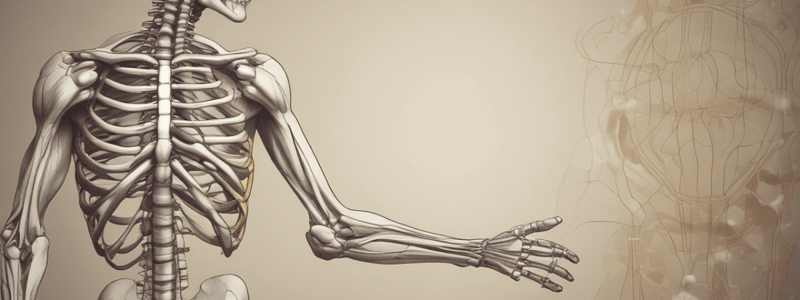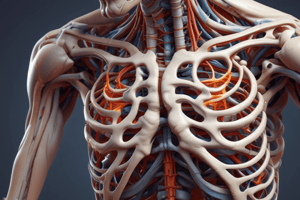Podcast
Questions and Answers
What type of synovial joint is the Glenohumeral Joint?
What type of synovial joint is the Glenohumeral Joint?
- Pivot joint
- Synovial hinge joint
- Synovial double-plane joint
- Synovial ball and socket joint (correct)
What is the movement that is NOT possible in the Elbow Joint?
What is the movement that is NOT possible in the Elbow Joint?
- Extension
- Medial rotation
- Flexion
- Abduction (correct)
Which of the following joints is NOT a type of synovial joint?
Which of the following joints is NOT a type of synovial joint?
- Skull sutures (correct)
- Acromioclavicular Joint
- Glenohumeral Joint
- Sternoclavicular Joint
What is the cause of dislocation of the Glenohumeral Joint?
What is the cause of dislocation of the Glenohumeral Joint?
What is the type of joint that connects the head of the radius and the trochlear notch of the ulna?
What is the type of joint that connects the head of the radius and the trochlear notch of the ulna?
What is the collective name for the joints that connect the radius and ulna?
What is the collective name for the joints that connect the radius and ulna?
Which of the following joints is structurally a weak joint?
Which of the following joints is structurally a weak joint?
What is the location of the Atlanto-Axial joint?
What is the location of the Atlanto-Axial joint?
What is the function of synovial fluid in a synovial joint?
What is the function of synovial fluid in a synovial joint?
Which type of synovial joint is characterized by a ball-shaped convex surface fitting into a socket-like concavity?
Which type of synovial joint is characterized by a ball-shaped convex surface fitting into a socket-like concavity?
Which joint is an example of a hinge joint?
Which joint is an example of a hinge joint?
What is the name of the joint that connects the atlas and axis bones in the neck?
What is the name of the joint that connects the atlas and axis bones in the neck?
Which type of synovial joint is characterized by a central bony axis surrounded by a bony-ligamentous ring?
Which type of synovial joint is characterized by a central bony axis surrounded by a bony-ligamentous ring?
What type of joint is the radio-ulnar joint?
What type of joint is the radio-ulnar joint?
Which joint is an example of an ellipsoid joint?
Which joint is an example of an ellipsoid joint?
What is the articulation of the distal radio-ulnar joint?
What is the articulation of the distal radio-ulnar joint?
What is the name of the joint that connects the humerus and scapula in the shoulder?
What is the name of the joint that connects the humerus and scapula in the shoulder?
What type of joint is the hip joint?
What type of joint is the hip joint?
Which type of synovial joint is characterized by reciprocally concavo-convex articular surfaces?
Which type of synovial joint is characterized by reciprocally concavo-convex articular surfaces?
What is the articulation of the wrist joint?
What is the articulation of the wrist joint?
What type of joint is the knee joint?
What type of joint is the knee joint?
What is the function of the anular ligament of the radius?
What is the function of the anular ligament of the radius?
What is the possible movement of the radio-ulnar joint?
What is the possible movement of the radio-ulnar joint?
What is the lateral collateral ligament of the knee joint?
What is the lateral collateral ligament of the knee joint?
Flashcards are hidden until you start studying
Study Notes
Joints of the Head and Neck
- Skull sutures: coronal, sagittal, lambdoid, and squamous sutures
- Temporo-Mandibular joint: articulation between the temporal bone and the mandible
- Atlanto-Axial joint: pivot joint, allows for rotation of the head
- Cervical Intervertebral joint: articulation between the vertebrae in the neck
Joints of the Pectoral Girdle
- Sterno-clavicular Joint: synovial double-plane joint, articulation between the sternal end of the clavicle, the manubrium sterni, and the first costal cartilage
- Acromio-clavicular Joint: synovial plane joint, articulation between the acromion of the scapula and the lateral end of the clavicle
- Glenohumeral Joint: synovial ball and socket joint, articulation between the head of the humerus and the glenoid cavity of the scapula, permits movements such as flexion, extension, abduction, adduction, medial rotation, lateral rotation, and circumduction
Joints of the Forearm
- Elbow joint: synovial hinge joint, articulation between the trochlea and capitulum of the humerus and the trochlear notch of the ulna and the head of the radius, permits only flexion and extension
- Radio-Ulnar Joint: two joints, superior and inferior, united by the interosseous membrane
- Superior Radio-Ulnar Joint: synovial pivot joint, articulation between the head of the radius and the radial notch of the ulna, permits pronation and supination
- Distal Radio-Ulnar Joint: synovial pivot joint, articulation between the rounded head of the ulna and the ulnar notch on the radius, permits pronation and supination
Wrist Joint
- Radio-Carpal Joint: synovial ellipsoid joint, articulation between the distal end of the radius and the articular disc of the ulna, and the scaphoid, lunate, and triquetral bones, permits flexion, extension, abduction, and adduction
Joints of the Hands
- Intercarpal joints: between the carpal bones
- Carpometacarpal joints: between the carpal bones and the metacarpal bones
- Metacarpophalangeal joints: between the metacarpal bones and the phalanges
- Interphalangeal joints: between the phalanges
Joints of the Lower Limb
- Hip joint: synovial ball and socket joint, articulation between the head of the femur and the acetabulum, permits movements such as flexion, extension, abduction, adduction, lateral and medial rotation, and circumduction
- Knee joint: synovial hinge joint, articulation between the condyles of the femur and the tibia, and the patella and the femur
Synovial Joints
- Articular surfaces are lubricated by synovial fluid
- The capsule is strengthened by ligaments which unite the bones together
- Classified into different types based on the shape of the articulating bones and the type of movement:
- Plane joints: flat articular surfaces, e.g. Acromioclavicular joint
- Hinge joints: only flexion and extension are possible, e.g. Elbow, knee, and ankle joints
- Pivot joints: central bony axis surrounded by a bony-ligamentous ring, only rotation is possible, e.g. Atlanto-axial joint and superior radioulnar joints
- Condyloid joints: two different convex surfaces articulate with two concave surfaces, e.g. Metacarpophalangeal joints
- Ellipsoid joints: elliptical convex articular surface fits into an elliptical concave articular surface, e.g. Wrist joint
- Saddle joint: reciprocally concavo-convex articular surfaces, e.g. Carpometacarpal joint of the thumb
- Ball and socket joints: ball-shaped convex surface fits into a socket-like concavity, e.g. Shoulder and hip joints
Studying That Suits You
Use AI to generate personalized quizzes and flashcards to suit your learning preferences.




